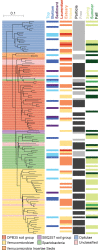Verrucomicrobia are prevalent in north-temperate freshwater lakes and display class-level preferences between lake habitats
- PMID: 29590198
- PMCID: PMC5874073
- DOI: 10.1371/journal.pone.0195112
Verrucomicrobia are prevalent in north-temperate freshwater lakes and display class-level preferences between lake habitats
Erratum in
-
Correction: Verrucomicrobia are prevalent in north-temperate freshwater lakes and display class-level preferences between lake habitats.PLoS One. 2018 Oct 22;13(10):e0206396. doi: 10.1371/journal.pone.0206396. eCollection 2018. PLoS One. 2018. PMID: 30346995 Free PMC article.
Abstract
The bacterial phylum Verrucomicrobia was formally described two decades ago and originally believed to be a minor member of many ecosystems; however, it is now recognized as ubiquitous and abundant in both soil and aquatic systems. Nevertheless, knowledge of the drivers of its relative abundance and within-phylum habitat preferences remains sparse, especially in lake systems. Here, we documented the distribution of Verrucomicrobia in 12 inland lakes in Southeastern Michigan, a Laurentian Great Lake (Lake Michigan), and a freshwater estuary, which span a gradient in lake sizes, depths, residence times, and trophic states. A wide range of physical and geochemical parameters was covered by sampling seasonally from the surface and bottom of each lake, and by separating samples into particle-associated and free-living fractions. On average, Verrucomicrobia was the 4th most abundant phylum (range 1.7-41.7%). Fraction, season, station, and depth explained up to 70% of the variance in Verrucomicrobia community composition and preference for these habitats was phylogenetically conserved at the class-level. When relative abundance was linearly modeled against environmental data, Verrucomicrobia and non-Verrucomicrobia bacterial community composition correlated to similar quantitative environmental parameters, although there were lake system-dependent differences and > 55% of the variance remained unexplained. A majority of the phylum exhibited preference for the particle-associated fraction and two classes (Opitutae and Verrucomicrobiae) were identified to be more abundant during the spring season. This study highlights the high relative abundance of Verrucomicrobia in north temperate lake systems and expands insights into drivers of within-phylum habitat preferences of the Verrucomicrobia.
Conflict of interest statement
Figures




Similar articles
-
Phylogenetic conservation of freshwater lake habitat preference varies between abundant bacterioplankton phyla.Environ Microbiol. 2016 Apr;18(4):1212-26. doi: 10.1111/1462-2920.13143. Epub 2016 Jan 18. Environ Microbiol. 2016. PMID: 26631909
-
Temporal dynamics and phylogenetic diversity of free-living and particle-associated Verrucomicrobia communities in relation to environmental variables in a mesotrophic lake.FEMS Microbiol Ecol. 2013 Jan;83(1):189-201. doi: 10.1111/j.1574-6941.2012.01469.x. Epub 2012 Sep 19. FEMS Microbiol Ecol. 2013. PMID: 22882302
-
Seasonal dynamics of the bacterioplankton community in a large, shallow, highly dynamic freshwater lake.Can J Microbiol. 2018 Nov;64(11):786-797. doi: 10.1139/cjm-2018-0126. Epub 2018 May 23. Can J Microbiol. 2018. PMID: 29791806
-
Competition and niche separation of pelagic bacteria in freshwater habitats.Environ Microbiol. 2017 Jun;19(6):2133-2150. doi: 10.1111/1462-2920.13742. Epub 2017 May 10. Environ Microbiol. 2017. PMID: 28370850 Review.
-
Morphometry and hydrology of the four large lakes of Sweden.Ambio. 2001 Dec;30(8):467-74. doi: 10.1579/0044-7447-30.8.467. Ambio. 2001. PMID: 11878020 Review.
Cited by
-
Assessment of Microbial Community Dynamics in River Bank Filtrate Using High-Throughput Sequencing and Flow Cytometry.Front Microbiol. 2018 Nov 29;9:2887. doi: 10.3389/fmicb.2018.02887. eCollection 2018. Front Microbiol. 2018. PMID: 30555435 Free PMC article.
-
Analysis of gut microbiota in patients with acute myocardial infarction by 16S rRNA sequencing.Ann Transl Med. 2022 Dec;10(24):1340. doi: 10.21037/atm-22-5671. Ann Transl Med. 2022. PMID: 36660636 Free PMC article.
-
Soil Water Contents Control the Responses of Dissolved Nitrogen Pools and Bacterial Communities to Freeze-Thaw in Temperate Soils.Biomed Res Int. 2020 Mar 11;2020:6867081. doi: 10.1155/2020/6867081. eCollection 2020. Biomed Res Int. 2020. PMID: 32258137 Free PMC article.
-
Expanded Phylogenetic Diversity and Metabolic Flexibility of Mercury-Methylating Microorganisms.mSystems. 2020 Aug 18;5(4):e00299-20. doi: 10.1128/mSystems.00299-20. mSystems. 2020. PMID: 32817383 Free PMC article.
-
Sulfuriroseicoccus oceanibius gen. nov., sp. nov., a representative of the phylum Verrucomicrobia with a special cytoplasmic membrane.Antonie Van Leeuwenhoek. 2022 Feb;115(2):337-352. doi: 10.1007/s10482-021-01689-2. Epub 2022 Jan 19. Antonie Van Leeuwenhoek. 2022. PMID: 35044567
References
-
- De Bont J, Staley J, Pankratz H. Isolation and description of a non-motile, fusiform, stalked bacterium, a representatieve of a new genus. Antonie van Leeuwenhoek. 1970;36(1):397–407. - PubMed
-
- Hedlund BP, Gosink JJ, Staley JT. Verrucomicrobia div. nov., a new division of the bacteria containing three new species of Prosthecobacter. Antonie van Leeuwenhoek. 1997;72(1):29–38. - PubMed
-
- Schlesner H. Verrucomicrobium spinosum gen. nov., sp. nov.: a fimbriated prosthecate bacterium. Syst Appl Microbiol. 1987;10(1):54–6.
Publication types
MeSH terms
Substances
LinkOut - more resources
Full Text Sources
Other Literature Sources

